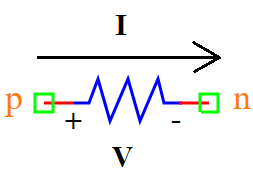Resistor
Symbol
Information

A resistor is a passive electrical component that opposes the flow of electric current. It follows Ohm’s Law, which defines the relationship between voltage, current, and resistance:
Where:
\(V\) is the voltage across the resistor (Volts)
\(I\) is the current flowing through the resistor (Amperes)
\(R\) is the resistance (Ohms, Ω)
Resistors are used for current limiting, voltage division, and circuit protection.
Ports
p: Positive terminal
n: Negative terminal
Symbol description
Field |
Value |
|---|---|
Symbol.name |
Resistor |
Symbol.file |
Resistor.sym |
Symbol.directory |
Basic |
Symbol.referance |
|
Model.name |
|
Model.file |
Resistor.py |
Model
The Resistor model implements a linear resistor.
A resistor limits the current flow in a circuit, and the voltage across it is directly proportional to the current through it.
Attributes:
V (signal): Input voltage signal across the resistor, defined between nodes (p, n).
I (signal): Output current signal through the resistor, defined between nodes (p, n).
R (param): Resistance value in Ohms (Ω), default is 1.0 kΩ.
Methods:
analog(): Defines the resistor behavior using the equation:
from pyams.lib import model, signal, param, voltage, current
class Resistor(model):
"""
Resistor model based on Ohm’s Law: V = R * I
"""
def __init__(self, p, n):
# Signal declaration
self.V = signal('in', voltage, p, n)
self.I = signal('out', current, p, n)
# Parameter declaration
self.R = param(1e3, 'Ω', 'Resistance value')
def analog(self):
"""Defines the resistor’s voltage-current relationship"""
self.I += self.V / self.R
Command syntax
The syntax for defining a resistor in a PyAMS simulation:
# Import the model
from pyams.models import Resistor
# Rname: is the name of the resistor instance
# p, n: The connection points in the circuit
Rname = Resistor(p, n)